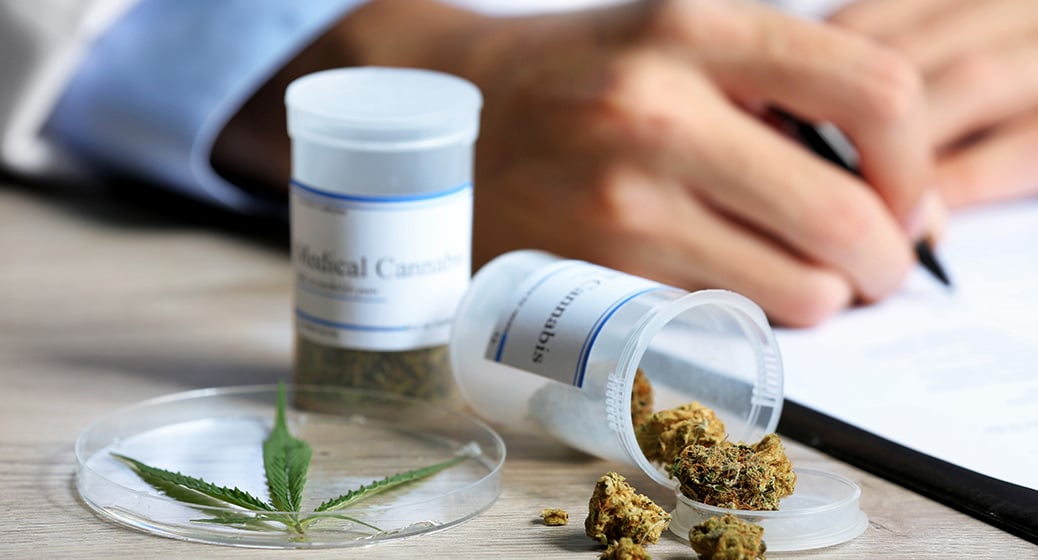The last decade has seen a significant shift in public perception toward the use of marijuana for medicinal purposes. Medical marijuana is now legal in 37 US states, and an estimated 3.6 million Americans hold medical marijuana cards. Yet, due to ongoing research restrictions, many healthcare providers feel ill-equipped to discuss the pros and cons of medical marijuana with their patients. Here is what you need to know about medical marijuana for your patients.
Is medical marijuana legal in my state?
Marijuana laws differ by state and change frequently, which can make it a little confusing to figure out what is legal for your patients. This website breaks down the legality of medical and recreational marijuana, CBD, and THC.
What is the difference between CBD and THC?
CBD and THC are two chemical compounds present in the marijuana plant. Because these compounds affect the body differently, they are subject to different state laws. Here are some key distinctions between CBD and THC.
CBD is not psychotropic and does not produce the “high” sensation associated with THC
THC is psychotropic and is a Schedule I controlled substance in the US
CBD is not a controlled substance and is non-addictive
THC can be addictive
THC is the active ingredient in most of the marijuana that is used recreationally
Medical marijuana often includes a mix of CBD and THC
What conditions does medical marijuana treat?
Again, state laws vary when it comes to the medical conditions that qualify for medical marijuana treatment. Most commonly, however, medical marijuana is used for the following:
Pain relief
Chemotherapy-induced nausea
Multiple sclerosis (MS)
AIDS
Seizure disorders
Glaucoma
ALS (Lou Gehrig’s disease)
Because you need a special license in order to study marijuana, there is limited research on its efficacy. However, there is the most evidence to support the use of marijuana as a treatment for seizures, MS, pain, and nausea associated with chemotherapy. More research is needed to determine whether marijuana is an effective treatment for anxiety, Tourette’s disorder, and nightmares associated with PTSD.
Is medical marijuana safe?
Like other drugs, medical marijuana carries a risk of abuse and adverse effects. Research suggests that 9 to 10 percent of all marijuana users will develop a moderate to severe dependence disorder, as classified by the DSM. In addition, a 2018 study suggests that people who use medical marijuana are more likely to use other prescription and non-prescription drugs.
Because medical marijuana is not regulated by the FDA, the dosage varies widely. The potency of medical marijuana also depends on whether it is administered orally, sublingually, or via inhalation. Many physicians do not include dosing recommendations when they recommend patients for medical marijuana, making it difficult to determine what is therapeutic and what could potentially be dangerous.
Short-term side effects of marijuana include:
Impaired short-term memory, motor coordination, and judgment
Paranoia or psychosis (usually present at higher doses)
Reduced REM sleep
Long-term side effects of marijuana include:
Addiction and withdrawal
Altered brain development, cognitive impairment, and educational/occupational underachievement
Increased risk of psychosis in patients with a predisposition
Lung damage/bronchitis (if inhaled)
In addition, marijuana can dysregulate endogenous neurotransmitter systems and may interfere with psychotherapy by impairing memory and preventing the development of internal regulation.
When should I be concerned about my patient’s medical marijuana use?
Therapists should use their professional judgment when assessing whether a patient is using medical marijuana therapeutically. However, here are some potential warning signs that warrant further inquiry:
Combining medical marijuana with other forms of chemical self-medication (e.g. alcohol, benzodiazepines)
Using more marijuana than recommended and/or supplementing with recreational or illegal marijuana use
Frequently changing prescribers
Driving under the influence
Using marijuana to induce euphoria rather than for symptom management
Evidence of impairment in one or more areas of functioning (e.g. absent/late to work, strained relationships)
What should I do if I am concerned about my patient’s medical marijuana use?
Patients need a written recommendation from a physician in order to obtain a medical marijuana card. If you can, get your patient’s permission to speak with the physician who wrote the recommendation. Express your concerns to the doctor, including any warning signs of abuse or impairment. You may also want to refer your patient to an addiction specialist for a risk assessment and second opinion.
If your patient is willing, take a harm-reduction approach by attempting to limit the negative consequences of use. Motivational interviewing can be used with patients who are in the early stages of readiness for change. Groups like Marijuana Anonymous can provide your patient with additional support. If your patient needs a more intensive approach, you may want to discuss addiction treatment facilities.
Keep Reading
Want more? Here are some other blog posts you might be interested in.









